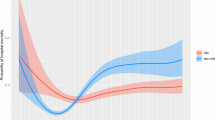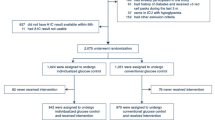Abstract
Objective
Elevated blood glucose is associated with poor outcome in patients resuscitated from out-of-hospital cardiac arrest (OHCA). Our aim was to determine whether strict glucose control with intensive insulin treatment improves outcome of OHCA patients.
Design
A randomized, controlled trial.
Setting
Two university hospital intensive care units.
Patients
Ninety patients resuscitated from OHCA with ventricular fibrillation detected as the initial rhythm were treated with therapeutic hypothermia.
Interventions
Patients were randomized into two treatment groups: a strict glucose control group (SGC group), with a blood glucose target of 4–6 mmol/l, or a moderate glucose control group (MGC group), with a blood glucose target of 6–8 mmol/l. Both groups were treated with insulin infusion for 48 h, because a control group with no treatment was considered unethical.
Measurements and results
Baseline data were similar in both groups. In the SGC group 71% of the glucose measurements were within the target range compared with 41% in the MGC group. Median glucose was 5.0 mmol/l in the SGC group and 6.4 mmol/l in the MGC group. The occurrence of moderate hypoglycemic episodes was 18% in the SGC group and 2% in the MGC group (p = 0.008). No episodes of severe hypoglycemia occurred. Mortality by day 30 was 33% in the SGC group and 35% in the MGC group (p = 0.846); the difference was 2% (95% CI –18% to +22%).
Conclusions
We found no additional survival benefit from strict glucose control compared with moderate glucose control with a target between 6 and 8 mmol/l in OHCA patients.


Similar content being viewed by others
References
Herlitz J, Castren M, Friberg H, Nolan JP, Skrifvars MB, Sunde K, Steen P (2006) Post resuscitation care: what are the therapeutic alternatives and what do we know? Resuscitation 69:15–22
Nolan JP, Deakin CD, Soar J, Böttiger BW, Smith G (2005) European Resuscitation Council Guidelines for Resuscitation 2005. Section 4. Adult advanced life support. Resuscitation 67:S39–S86
Langhelle A, Tyvold S, Lexow K, Hapnes S, Sunde K, Steen P (2003) In-hospital factors associated with improved outcome after out-of-hospital cardiac arrest. A comparison between four regions in Norway. Resuscitation 56:247–263
Skrifvars MB, Pettilä V, Rosenberg PH, Castren M (2003) A multiple logistic regression analysis of in-hospital factors related to survival at six months in patients resuscitated from out-of-hospital ventricular fibrillation. Resuscitation 59:319–328
HACA Study Group (2002) Mild therapeutic hypothermia to improve the neurologic outcome after cardiac arrest. N Engl J Med 346:549–556
Bernard SA, Gray TW, Buist MD, Jones BM, Silvester W, Gutteridge G, Smith K (2002) Treatment of comatose survivors of out-of-hospital cardiac arrest with induced hypothermia. N Engl J Med 346:557–563
Nolan JP, Morley PT, Vanden Hoek TL, Hickey RW (2003) Therapeutic hypothermia after cardiac arrest. An advisory statement by the advanced life support task force of the international liaison committee on resuscitation. Circulation 108:118–121
Van den Berghe G, Wouters PJ, Weekers F, Verwaest C, Bruyninckx F, Schetz M, Vlaesselaers D, Ferdinande P, Lauwers P, Bouillon R (2001) Intensive insulin therapy in critically ill patients. N Engl J Med 345:1359–1367
Van den Berghe G, Wilmer A, Hermans G, Meersseman W, Wouters PJ, Milants I, Van Wijngaerden E, Bobbaers H, Bouillon R (2006) Intensive insulin therapy in the medical ICU. N Engl J Med 354:449–461
Meynaar I, Oudemans-van Straaten H, van der Wetering J, Verlooy P, Slaats E, Bosman R, van der Spoel J, Zandstra D (2003) Serum neuron-specific enolase predicts outcome in post-anoxic coma: a prospective cohort study. Intensive Care Med 29:189–195
Schoerkhuber W, Kittler H, Sterz F, Behringer W, Holzer M, Frossard M, Spitzauer S, Laggner A (1999) Time course of serum neuron-specific enolase: a predictor of neurological outcome in patients resuscitated from cardiac arrest. Stroke 30:1598–1603
Rosén H, Stibrant Sunnerhagen K, Herlitz J, Blomstrand C, Rosengren L (2001) Serum level of the brain-derived proteins S-100 and NSE predict long-term outcome after cardiac arrest. Resuscitation 49:183–191
Tiainen M, Roine RO, Pettilä V, Takkunen O (2003) Serum neuron-specific enolase and S-100B protein in cardiac arrest patients treated with hypothermia. Stroke 34:2881–2886
De Latorre F, Nolan JP, Robertson C, Chamberlain D, Baskett P (2001) European Resuscitation Council guidelines 2000 for adult advanced life support. Resuscitation 48:211–221
Longstreth W, Inui T (1984) High blood glucose level on hospital admission and poor neurological recovery after cardiac arrest. Ann Neurol 15:59–63
Müllner M, Sterz F, Binder M, Schreiber W, Deimel A, Laggner AN (1997) Blood glucose concentration after cardiopulmonary resuscitation influences functional neurological recovery in human cardiac arrest survivors. J Cereb Blood Flow Metab 17:430–436
Preiser J-C, Devos P (2007) Steps for the implementation and validation of tight glucose control. Intensive Care Med 33:570–571
Van den Berghe G, Wilmer A, Milants I, Wouters PJ, Bouckaert B, Bruyninckx F, Bouillon R, Schetz M (2006) Intensive insulin therapy in mixed medical/surgical intensive care units. Benefit versus harm. Diabetes 55:3151–3159
Finney SJ, Zekveld C, Elia A, Evans TW (2003) Glucose control and mortality in critically ill patients. JAMA 290:2041–2047
Vriesendorp T, DeVries J, van Santen S, Moeniralam H, de Jonge E, Roos Y, Schultz M, Rosendaal F, Hoekstra J (2006) Evaluation of short-term consequences of hypoglycemia in an intensive care unit. Crit Care Med 34:2714–2718
Brunkhorst FM, Kuhnt E, Engel C, Meier-Hellmann A, Ragaller M, Quintel M et al. (2005) Intensive insulin therapy in patient with severe sepsis and septic shock is associated with an increased rate of hypoglycemia—results from a randomized multicenter study (VISEP). Infection 33:19–20
Brunkhorst FM, Reinhart K (2007) Intensive insulin therapy in the ICU: benefit versus harm? Intensive Care Med 33:1302
Kanji S, Singh A, Tierney M, Meggison H, McIntyre L, Hebert PC (2004) Standardization of intravenous insulin therapy improves the efficiency and safety of blood glucose control in critically ill adults. Intensive Care Med 30:804–810
Meynaar IA, Dawson L, Tangkau PL, Salm EF, Rijks L (2007) Introduction and evaluation of a computerised insulin protocol. Intensive Care Med 33:591–596
Sunde K, Pytte M, Jacobsen D, Mangschau A, Jensen LP, Smedsrud C, Draegni T, Steen PA (2007) Implementation of a standardised treatment protocol for post resuscitation care after out-of-hospital cardiac arrest. Resuscitation 73:29–39
Acknowledgements
We would like to thank for funding the Laerdal Foundation and the Instrumentarium Foundation, and for data collection the medical student Erkko Klemetti, and the study nurses Pia Simon, Nina Nakari, Leena Pettilä, Kirsi Ruohomäki, and Teemu Hult and the ICU personnel in the Jorvi and Meilahti hospitals.
Author information
Authors and Affiliations
Corresponding author
Additional information
Descriptor: 21. Cardiopulmonary resuscitation
Rights and permissions
About this article
Cite this article
Oksanen, T., Skrifvars, M.B., Varpula, T. et al. Strict versus moderate glucose control after resuscitation from ventricular fibrillation. Intensive Care Med 33, 2093–2100 (2007). https://doi.org/10.1007/s00134-007-0876-8
Received:
Accepted:
Published:
Issue Date:
DOI: https://doi.org/10.1007/s00134-007-0876-8




